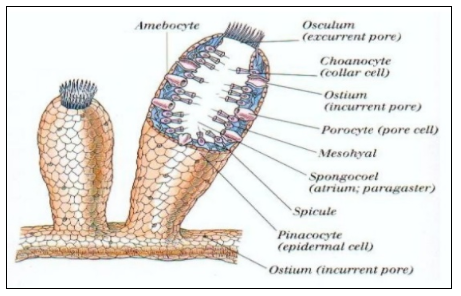
Sycon belongs to a group of animals which are best described as
a) Unicellular or acellular
b) Multicellular without any tissue organization
c) Multicellular with a gastrovascular system
d) Multicellular having tissue organization, but nobody cavity
Answer
589.5k+ views
Hint: Sycons are the sponges with the cellular level of body organization with numerous pores on their calceiform body and have canal systems. In Sycon each cell acts independently and shows very little coordination.
Complete answer:
Sycon belongs to phylum-Porifera (cellular sponges) and is the most primitive group of multicellular organisms. They belong to class Calcarea having spicules made of calcium carbonate in the form of calcite. They have a cellular level of organization where the cells do not form tissues and more or less work independently with very little coordination. Thus, Sycons are the multicellular sponges without any tissue organization.

Figure 1: Development of Sycon

Figure 2: Sycon cellular level of organization
Additional information
1)Though the cellular level of organization in Sycon shows the independent working of each cell with little coordination, there is some division of labor present among the cells, based on which the cells work independently performing only the function assigned to them.
2)Another important feature of Sycon includes the presence of the Canal system, formed from pores on the walls that penetrate into the body forming the water channels and spongocoel (the large central canal).
Therefore the correct answer ‘Multicellular without any tissue organization’.
Note: Sycon is a member of Porifera phylum known as pore bearers as their body is made up of body walls that possess many tiny pores (known as Ostia), giving it a sponge-like look. They exhibit cell aggregate body plan and thus are included in the sub-kingdom of Parazoa.
Complete answer:
Sycon belongs to phylum-Porifera (cellular sponges) and is the most primitive group of multicellular organisms. They belong to class Calcarea having spicules made of calcium carbonate in the form of calcite. They have a cellular level of organization where the cells do not form tissues and more or less work independently with very little coordination. Thus, Sycons are the multicellular sponges without any tissue organization.

Figure 1: Development of Sycon

Figure 2: Sycon cellular level of organization
Additional information
1)Though the cellular level of organization in Sycon shows the independent working of each cell with little coordination, there is some division of labor present among the cells, based on which the cells work independently performing only the function assigned to them.
2)Another important feature of Sycon includes the presence of the Canal system, formed from pores on the walls that penetrate into the body forming the water channels and spongocoel (the large central canal).
Therefore the correct answer ‘Multicellular without any tissue organization’.
Note: Sycon is a member of Porifera phylum known as pore bearers as their body is made up of body walls that possess many tiny pores (known as Ostia), giving it a sponge-like look. They exhibit cell aggregate body plan and thus are included in the sub-kingdom of Parazoa.
Recently Updated Pages
The number of solutions in x in 02pi for which sqrt class 12 maths CBSE

Write any two methods of preparation of phenol Give class 12 chemistry CBSE

Differentiate between action potential and resting class 12 biology CBSE

Two plane mirrors arranged at right angles to each class 12 physics CBSE

Which of the following molecules is are chiral A I class 12 chemistry CBSE

Name different types of neurons and give one function class 12 biology CBSE

Trending doubts
One Metric ton is equal to kg A 10000 B 1000 C 100 class 11 physics CBSE

What is 1s 2s 2p 3s 3p class 11 chemistry CBSE

Discuss the various forms of bacteria class 11 biology CBSE

State the laws of reflection of light

Explain zero factorial class 11 maths CBSE

An example of chemosynthetic bacteria is A E coli B class 11 biology CBSE




